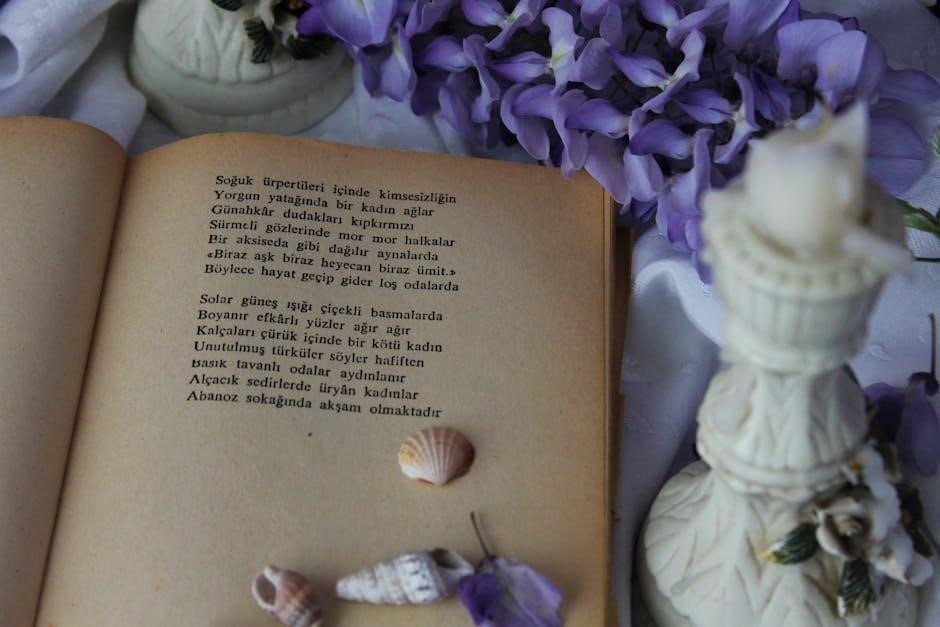
to his coy mistress poem pdf
Background and Historical Context
Andrew Marvell’s To His Coy Mistress emerges from the 17th-century literary landscape, reflecting the intellectual and artistic currents of the time. Marvell, a prominent political figure and poet, crafted this metaphysical poem amid the cultural shifts of his era, blending wit, philosophy, and romance.
1.1 Andrew Marvell and His Era
Andrew Marvell, a prominent 17th-century English poet, politician, and satirist, lived during a time of significant political and cultural upheaval. Born in 1621, Marvell was active during the English Civil War and the Restoration, experiences that shaped his worldview and literary style. Known for his wit and intellectual depth, Marvell was celebrated for his satirical works during his lifetime, while his serious poetry, including To His Coy Mistress, gained recognition posthumously. His metaphysical poetry, characterized by complex imagery and philosophical themes, reflects the intellectual currents of his era. Marvell’s dual role as a poet and politician underscores his ability to bridge artistic expression with the realities of his time, making him a unique figure in English literary history.
1.2 The Publication and Reception of the Poem
To His Coy Mistress was not published during Marvell’s lifetime, first appearing in print in 1681, three years after his death. The poem gained limited attention initially, as Marvell’s serious poetry was overshadowed by his satirical works. However, its reputation grew over the centuries, particularly in the 20th century, when it became a celebrated example of metaphysical poetry. Critics praised its intricate structure, vivid imagery, and exploration of themes such as time, mortality, and desire. The poem’s enduring popularity lies in its universal appeal, transcending its historical context to resonate with modern readers. Its publication posthumously ensured its legacy, solidifying Marvell’s place among the greatest English poets.

Poetic Structure and Style
To His Coy Mistress showcases Marvell’s mastery of metaphysical poetry, blending intricate imagery with logical argumentation. Its structured form, employing iambic tetrameter and couplets, creates a rhythmic flow that underscores the poem’s emotional intensity and intellectual depth. The use of precise diction and clever wordplay enhances its artistic appeal, while the logical progression of ideas reinforces its persuasive intent. Marvell’s style seamlessly intertwines passion and philosophy, making the poem a compelling exploration of desire and mortality. The structured yet fluid composition reflects the poem’s thematic interplay, offering readers a rich tapestry of sound and sense.
2.1 Meter, Rhyme, and Stanzaic Form

Andrew Marvell’s To His Coy Mistress is crafted in iambic tetrameter, with a consistent rhyme scheme of couplets, creating a rhythmic and musical quality. The poem’s meter, characterized by four beats per line, enhances its fluidity and emotional impact. The rhyme scheme, often following an AABB pattern, adds structural elegance and reinforces the speaker’s persuasive tone. The stanzaic form is divided into three distinct sections, each addressing a different phase of the argument. This division allows Marvell to build his case incrementally, moving from idealized love to the urgency of mortality. The interplay of meter, rhyme, and stanzaic form not only underscores the poem’s thematic progression but also highlights its artistic precision and intellectual depth. The structural elements work harmoniously to convey the speaker’s passion and logic, making the poem a masterclass in poetic craftsmanship. The careful arrangement of lines and stanzas ensures that the poem’s emotional and philosophical layers are seamlessly intertwined, providing a rich and complex reading experience.
2.2 The Use of Iambic Tetrameter and Couplets

The poem employs iambic tetrameter, a meter with four iambs (unstressed syllable followed by a stressed one) per line, creating a rhythmic flow that mirrors natural speech. This meter adds a sense of urgency and movement, underscoring the carpe diem theme. The use of couplets, or rhyming pairs of lines, reinforces the poem’s structure and enhances its musicality. Marvell skillfully uses this form to build persuasive arguments, with each couplet advancing the speaker’s case. The combination of iambic tetrameter and couplets allows for both lyrical expression and logical progression, making the poem accessible yet profound. The consistent rhythm and rhyme scheme also serve to emphasize key phrases, such as “world enough and time,” embedding them in the reader’s memory. This dual use of form and function heightens the poem’s emotional and intellectual impact, showcasing Marvell’s mastery of poetic technique.
Themes and Symbolism
The poem explores themes of time, mortality, desire, and the fleeting nature of beauty, using symbols like “world enough and time” to emphasize urgency and transience.
3.1 The Carpe Diem Motif
The poem embodies the carpe diem motif, urging the mistress to seize the present and embrace love before time runs out. Marvell uses vivid imagery and logical persuasion to convey the inevitability of mortality, contrasting the idealized leisure of endless time with the harsh reality of life’s brevity. The speaker’s argument is layered, blending romantic allure with existential urgency, making the poem a quintessential expression of the “seize the day” philosophy. This motif is central to the poem’s emotional and intellectual impact, resonating with readers across centuries.
3.2 The Interplay of Time, Desire, and Mortality
The poem intricately weaves together themes of time, desire, and mortality, creating a philosophical dialogue between romantic longing and existential reality. Marvell’s speaker acknowledges the power of desire but juxtaposes it with the relentless passage of time and the inevitability of death. The first section idealizes a timeless love, while the second confronts the harshness of mortality, and the third resolves with a call to action, urging the mistress to embrace life’s fleeting nature. This interplay heightens the emotional and intellectual tension, making the poem a profound exploration of human experience. The balance between poetic beauty and philosophical depth underscores Marvell’s mastery of metaphysical poetry.

The Mistress’s Perspective
The mistress embodies a complex mix of autonomy and allure, challenging traditional passive portrayals. Modern interpretations highlight her agency, reframing her “coyness” as a strategic, empowered response to societal expectations.
4.1 Feminine Agency in the Poem
The poem presents the mistress as a figure of quiet resistance, her coyness a form of feminine agency in a patriarchal world. Marvell portrays her as a woman who wields her reticence as a power, challenging the speaker’s persuasive arguments. While the speaker presses for immediate gratification, she exercises control over her desires and choices, embodying a subtle yet significant form of autonomy. This dynamic highlights the tension between societal expectations and personal will, offering a nuanced exploration of gender roles in 17th-century England. The mistress’s demeanor thus becomes a metaphor for the struggle between compliance and self-determination, adding depth to the poem’s exploration of power and relationships.
4.2 Modern Interpretations of the Mistress’s Role
Modern readings of To His Coy Mistress often reinterpret the mistress’s role through a feminist lens, emphasizing her autonomy and silent resistance. Critics argue that her coyness represents a strategic negotiation of power within a patriarchal society. Some view her as a symbol of female agency, challenging the speaker’s persuasive tactics and asserting her own desires. Additionally, contemporary interpretations highlight the poem’s problematic undertones, such as the pressure exerted on the mistress to conform to societal expectations of love and intimacy. These analyses underscore the complexity of her role, shifting focus from passive object to active participant in the dialogue. This reevaluation reflects broader discussions about gender dynamics and power in early modern literature.

Legacy and Influence
To His Coy Mistress remains a cornerstone of English literature, inspiring countless adaptations and references in modern culture, poetry, and art, cementing its timeless appeal and intellectual depth.
5.1 The Poem’s Enduring Popularity
To His Coy Mistress has maintained its status as a literary masterpiece, widely studied and admired for its intricate blend of wit, philosophy, and emotional depth. Its exploration of universal themes such as time, desire, and mortality resonates across generations, making it a timeless classic in English literature.
The poem’s enduring popularity is also due to its accessibility and the provocative nature of its arguments, which challenge readers to reflect on life’s fleeting nature. It continues to be a subject of academic analysis and inspiration for poets, ensuring its lasting relevance in literary and cultural discourse.
5.2 Literary and Cultural References to the Poem
To His Coy Mistress has left an indelible mark on literature and culture, inspiring countless references and allusions. The poem’s iconic phrases, such as “Had we but world enough and time,” have become part of the cultural lexicon, frequently appearing in works of fiction, film, and music. Its themes and imagery have influenced writers like T.S. Eliot and Sylvia Plath, who drew upon its rich metaphysical and emotional depth.
The poem’s influence extends beyond academia, with modern adaptations and reinterpretations keeping it relevant. Its exploration of desire and mortality continues to captivate audiences, ensuring its place as a cornerstone of literary and cultural heritage.